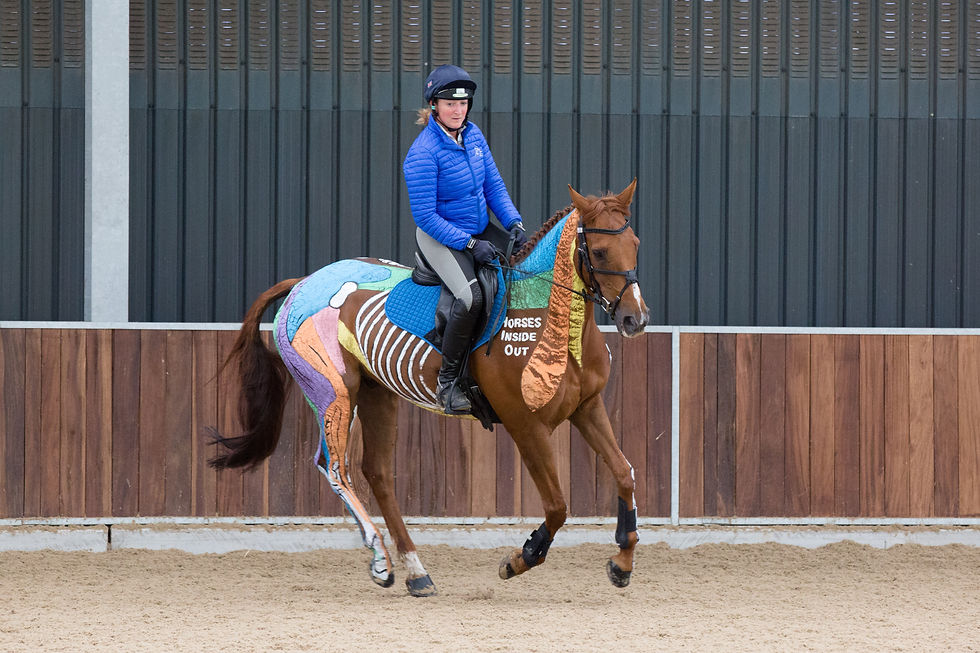How does your horse use his body to jump and how can jumping help your horse?
Find out more with Horses Inside Out.
This year I was very fortunate to be asked to be a part of the preparation and filming for a series of Horses Inside Out lecture demonstrations that were to be aired this Autumn as a series of live webinars.
You can read more about the filming days for these webinars at the Horses Inside Out Blog page.
The latest to be released was the final episode – Jumping From An Anatomical Approach.
I was really excited to watch this webinar as the filming day was so fun to do, but with being so busy helping it’s difficult to take in everything Gillian is explaining and saying, so I knew that I would still be able to learn so much watching this back.
The other thing I love about the live webinars is that participants have the opportunity to ask Gillian questions as the lecture demonstration is played out and this always adds another dimension to the information you can get from the demo.
For this demo we had 2 very different horses and riders. Nathan Bull, a professional show jumper, riding Jackpot and Fiona Davison, a professional eventer, riding her horse Pete. You can find out more about the horses and riders here. However, what I found interesting is although both horses and riders compete in showjumping, the horses are very different to watch when warming up, jumping and cooling down, yet the exercises Gillian asks the riders to complete are effective for both horses and she does a great job of explaining why they work and the effect the exercises are having on the horse’s bodies and movement.

Before getting into the ridden exercises though Gillian spends some time discussing the bones, muscles and muscle chains that are painted onto each horse and why she has chosen to demonstrate these certain areas due to the focus of the demo being jumping.
Some of my favourite facts from this section:
· As a horse travels over a jump you will notice they will lower their head in mid air which helps lift their back over the jump
· The horse is using the weight of their head and neck to affect their balance
· The head accounts for about 4% of the horse’s entire body weight
· The neck accounts for about 6% of the horse’s entire body weight
· The Nuchal Ligament lifts the back when the horse’s head is down
Not sure what the Nuchal Ligament is? You can find out more in this lecture demonstration.
Here I am (yes that’s me holding the pole) helping to demonstrate this relationship between the head, neck, Nuchal Ligament and back.
I was also in the demo to help Gillian explain the relationship between the neck and the hip in the horse.
For maximum hip extension the horse’s neck needs to be telescoping out. This is why it is important to allow elongation of the neck in particular when jumping spreads with your horse.
Here we are helping to demonstrate this relationship in the horse’s body.
This doesn’t just apply to jumping though. For those of you more interested in flat work or dressage, this relationship is also important to consider when asking for the medium trot.
One thing I really like in this demo is also how Gillian gets us thinking about assessing horses for their suitability for a certain job – in this example jumping.
To help elevate the forehand in order to be able to jump your horse will need to have good development of the Gluteal Muscles (those are the big butt muscles).

Gillian often talks about muscle chains, and the gluteal muscles are part of the Forehand Elevation Chain of muscles.
If your horse has good gluteal development you can predict that they should be light in front.
If your horse has more development in the hamstrings and less in the glutes they will be better at running on the forehand or on the flat, like a racehorse.
Ultimately though we should all be aiming for a good balance of the Extensor and Flexor chains of muscles for a healthy body and a good jumping horse.
There is tons more information on the muscle chains in this lecture demonstration as well as some of Gillian’s previous ones and her books.
Gillian also discusses far more about the horse’s bodies in relation to jumping than I can include in this blog, before asking the riders to mount up.
We then get the chance to watch them warm up the horses with a series of exercises including lateral work and ground poles and cavalettis, before performing a series of jumping exercises where Gillian explains how the exercises can be adapted to achieve different outcomes with your horse including shortening strides and achieving a different shape over a jump.
It really is a fantastic watch. And also demonstrates well the importance of cross training your horses and how they will benefit from this even if they are not a jumping specific horse.
Of course you can always jump your horse on the lunge or free school if riding over jumps isn’t your thing and your horse can then still benefit from these gymnastic exercises.
This lecture demonstration is now available to purchase as a stand alone item, or you can purchase it as part of the set of 4 webinars in which you can follow the series as Gillian intended, with each one building on the information of the previous one. All available at the Horses Inside Out Academy.
It’s the perfect time of year to curl up on the sofa with a cuppa and learn more about your horse for both of your benefits!












Comments